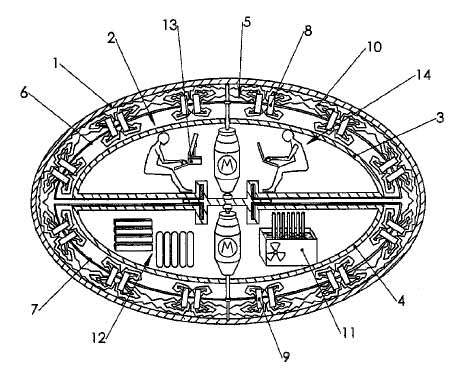It was back in 2005 that Boris Volfson was granted a US patent for a device which has been erroneously summarised by some as a Flying Saucer. But which is more accurately described as a Space Vehicle Propelled by the Pressure of Inflationary Vacuum State. Although the patent explained at length how “A levitating, rotating, superconducting disk“ might be able to develop a temporary egg-shaped space-time anomaly sufficient to allow a passenger vehicle to travel faster than light, the exact physics behind the crucial component known as the ‘Phonon Maser’ remained opaque to many readers. Fortunately, Volfson clarified his ideas in a subsequent paper which he published in Feb. 2006, entitled ‘On the Nature of Gravitaty and the Synthetic Gravitational Waves’.
Sadly though, Volfson’s internet domain (www.borisvolfson.com) lapsed into disuse and the paper consequently disappeared. But Improbable has been able to track down a copy – which has been preserved almost in its entirety by archive.org, and can be read in full here. Volfson explains that “In a flat, cooled superconductor disk, the electrons are bound into Cooper pairs energized at a ground level. Released into a vacuum, the phonons (initially formed to pair the electrons into Cooper pairs) affect the crystal lattice of the vacuum causing gravitational effects.” Though the effects are small, says Volfson, they can be amplified by means of his Gravitophonon Maser, which can produce a “…collimated, coherent, and all-penetrating beam of bundles of superposed guest phonons.”
Thus “By creating repulsion (and expanding spacetime) behind the spaceship and creating gravity (and contracting spacetime) in front of it, the spaceship engine could generate high-speed propulsion.” And in 2007 it was announced that a UK-based company – Gravity Machines Ltd – would begin development of the technology, and as a result was slated to become “…one of the largest and most profitable corporations in the world.”
ADDENDUM: Although Gravitaty research is still a fairly limited field at the present time, there are nonetheless centres of excellence.
Notably: the International Association of Geodesy, which is investigating Gravitaty Field Determination, and the University of Twente in the Netherlands which is in the process of perfecting their Gravitaty Gradiometer.
